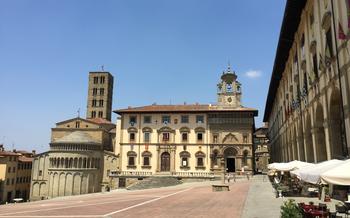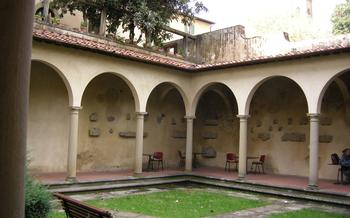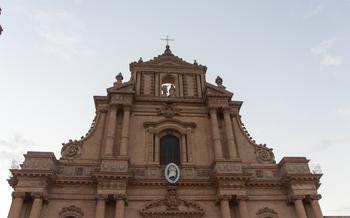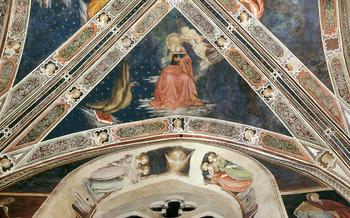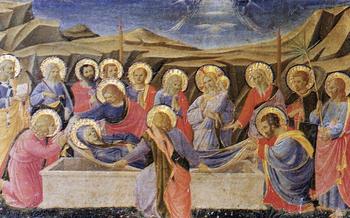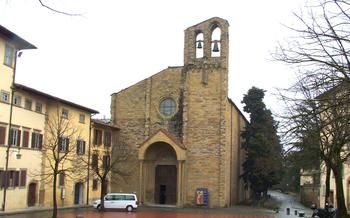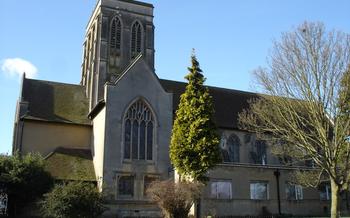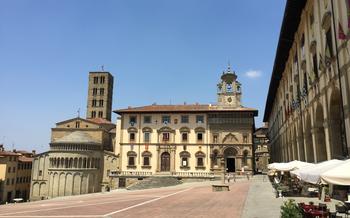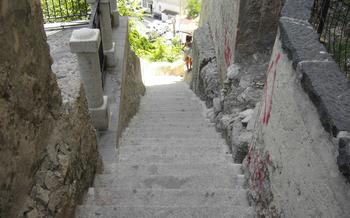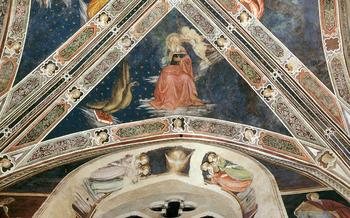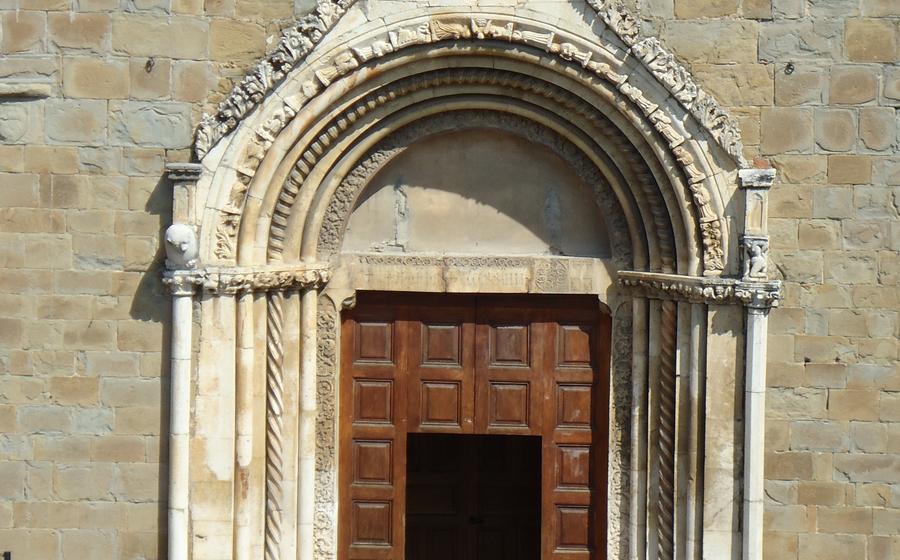
Chiesa di Sant'Agostino
- Chiesa di Sant'Agostino: A Masterpiece of Art and Faith in Arezzo
- Historical Context
- Exterior Exploration
- Interior Marvels
- Altarpiece Masterpieces
- Stained Glass Splendor
- Architectural Details
- Sculpture and Statues
- Significance in Art History
- Restoration and Preservation
- Religious Significance
- Local Customs and Etiquette
- Accessibility and Facilities
- In the Footsteps of History: Unveiling the Hidden Tapestry of the Chiesa di Sant'Agostino
Chiesa di Sant'Agostino: A Masterpiece of Art and Faith in Arezzo
Nestled in the heart of Arezzo, a captivating city in Tuscany, stands a magnificent architectural gem that has captivated the hearts of art enthusiasts and pilgrims for centuries – the Chiesa di Sant'Agostino. This sacred edifice, a testament to the enduring legacy of the Augustinian order, invites visitors to embark on a journey of artistic wonders, historical significance, and spiritual enlightenment. As you step through its ancient doors, prepare to be awestruck by the breathtaking beauty that unfolds within, where every corner whispers tales of devotion, artistry, and the pursuit of the divine.
Historical Context
The Chiesa di Sant'Agostino, nestled in the heart of Arezzo, Italy, boasts a rich and storied past that dates back to the 13th century. Founded by the Augustinian order, this magnificent edifice stands as a testament to the order's unwavering dedication to faith and scholarship. The Augustinians, known for their pursuit of knowledge and spiritual enlightenment, played a pivotal role in shaping the intellectual and religious landscape of Arezzo during the Middle Ages.
Architecturally, the church showcases a harmonious blend of Gothic and Renaissance influences, reflecting the transition from the medieval to the modern era. Its Gothic roots are evident in the pointed arches, ribbed vaults, and intricate tracery that adorn the structure, while Renaissance elements such as classical columns, pilasters, and rounded arches add a touch of elegance and refinement. This architectural synthesis creates a visually stunning masterpiece that captivates visitors with its timeless beauty.
Exterior Exploration
The exterior of the Chiesa di Sant'Agostino is a captivating blend of Gothic and Renaissance architectural styles. The façade, designed by architect Niccolò di Francesco, is a testament to the intricate detailing and masterful craftsmanship that characterized the era. Its most striking feature is the central portal, adorned with intricate carvings depicting biblical scenes and surmounted by a graceful lunette window.
Look up to admire the church's imposing bell tower, a later addition completed in the 16th century. Its slender form and elegant octagonal lantern make it a distinctive landmark on the Arezzo skyline. The harmonious interplay between the tower's Gothic base and Renaissance upper section showcases the evolution of architectural styles during this transitional period.
Interior Marvels
Stepping inside the Chiesa di Sant'Agostino is akin to entering a sacred gallery, where every wall and ceiling transforms into a canvas adorned with breathtaking frescoes and paintings. Among these artistic treasures, the most renowned is the legendary fresco cycle "The Legend of the True Cross" by Piero della Francesca. This awe-inspiring series of frescoes narrates the captivating journey of the True Cross, from its origins as a mere tree to its ultimate transformation into the symbol of salvation.
Della Francesca's masterful brushstrokes bring to life each scene with exquisite detail and vibrant colors, capturing the essence of the biblical tale. Witness the felling of the tree, its transformation into the cross upon which Christ was crucified, and its miraculous rediscovery by Saint Helena, the mother of Emperor Constantine. The artist's genius is evident in the lifelike expressions, intricate compositions, and harmonious use of perspective, creating an immersive experience that transports viewers back in time.
Other notable artworks within the church include the "Madonna and Child with Saints" by Margaritone d'Arezzo, a delicate and poignant depiction of the Virgin Mary cradling the infant Jesus, flanked by a host of venerated saints. The "Crucifixion" by Niccolò di Pietro Gerini is another masterpiece, showcasing the emotive power of the crucifixion scene through its dramatic portrayal of Christ's suffering and the anguish of his followers.
The Chiesa di Sant'Agostino is a veritable treasure trove of artistic wonders, a testament to the creative genius of the Italian Renaissance. Each fresco and painting within its hallowed walls tells a story, invites contemplation, and leaves an indelible mark on the soul of every visitor.
Altarpiece Masterpieces
The Chiesa di Sant'Agostino is renowned for its exceptional altarpieces, which are considered masterpieces of the Italian Renaissance. The high altar features a stunning altarpiece by Piero della Francesca, entitled "The Madonna and Child with Saints." This iconic work depicts the Virgin Mary enthroned with the infant Jesus, surrounded by a host of saints, including John the Baptist, Augustine of Hippo, and Nicholas of Bari. The painting is characterized by its serene composition, harmonious colors, and intricate attention to detail, showcasing Piero della Francesca's mastery of perspective and realism.
Another notable altarpiece is "The Adoration of the Magi" by Spinello Aretino, located in the left transept. This vibrant and dynamic painting portrays the Three Wise Men presenting their gifts to the infant Jesus, surrounded by a colorful procession of angels and attendants. Aretino's use of rich colors and expressive figures captures the sense of wonder and awe that accompanies the biblical event.
These altarpieces, along with others housed within the church, offer a glimpse into the artistic and spiritual heritage of Arezzo. They are testaments to the skill and devotion of the artists who created them and continue to inspire visitors with their beauty and significance.
Stained Glass Splendor
The Chiesa di Sant'Agostino is renowned for its exquisite stained glass windows, which bathe the interior in a kaleidoscope of colors and create a breathtaking atmosphere. Crafted by skilled artisans, these windows depict biblical scenes and stories of saints with intricate detail and vibrant hues. The iconography and symbolism embedded in the stained glass are deeply rooted in religious tradition, offering visitors a glimpse into the spiritual significance of the church.
One of the most captivating stained glass windows depicts the "Annunciation," portraying the moment when the angel Gabriel appeared to Mary to announce the birth of Jesus. The radiant colors and delicate brushstrokes convey the celestial nature of the event, while the expressions on Mary's and Gabriel's faces capture the emotions of awe and humility.
Another notable window showcases the "Crucifixion," a poignant representation of Jesus' sacrifice on the cross. The rich red and blue hues create a sense of drama and sorrow, while the intricate details in the depiction of Jesus' body and the surrounding figures convey the profound emotional and physical suffering endured during this pivotal moment.
These stained glass masterpieces not only enhance the beauty of the church's interior but also serve as a testament to the artistic skill and devotion of the artisans who created them. Visitors can spend hours admiring the intricate details and contemplating the spiritual significance of these luminous works of art.
Architectural Details
The Chiesa di Sant'Agostino showcases intricate architectural details that blend Gothic and Renaissance styles, creating a harmonious and visually stunning interior. The ribbed vaults, a characteristic feature of Gothic architecture, soar overhead, creating a sense of height and grandeur. These vaults are supported by elegant pointed arches, which add to the church's vertical emphasis. The decorative capitals that adorn the columns and pilasters feature intricate carvings of plant motifs, human figures, and biblical scenes, demonstrating the skill and artistry of the craftsmen who worked on the church. These architectural elements contribute significantly to the overall aesthetic appeal and structural integrity of the Chiesa di Sant'Agostino, making it a testament to the architectural prowess of its builders.
Sculpture and Statues
The Chiesa di Sant'Agostino boasts a remarkable collection of sculptures and statues that adorn its interior and exterior, adding to its artistic and spiritual allure. These artworks, meticulously crafted by talented sculptors, depict religious figures and scenes with intricate detail and profound symbolism.
Among the notable sculptures is the "Madonna and Child" by Giovanni di Francesco, a masterpiece of the 14th century. Carved from delicate marble, the sculpture captures the tender bond between the Virgin Mary and the infant Jesus. The serene expression on Mary's face and the gentle embrace of the child evoke a sense of divine love and compassion.
Another highlight is the "Saint Augustine" statue by Urbano da Cortona, a 16th-century sculptor known for his mastery of anatomical detail. The statue portrays Saint Augustine, the church's patron saint, with a contemplative gaze and a book in his hand, symbolizing his devotion to knowledge and faith. The intricate folds of his robes and the finely rendered features of his face showcase the artist's exceptional skill.
These sculptures and statues serve as a testament to the artistic prowess of their creators and contribute to the rich visual tapestry of the Chiesa di Sant'Agostino. They invite visitors to pause and contemplate the stories and symbolism behind each piece, deepening their understanding of the church's religious and cultural significance.
Significance in Art History
The Chiesa di Sant'Agostino holds a prominent place in the annals of art history, serving as a testament to the transition from the Gothic to the Renaissance periods. Its architectural fusion of Gothic elements, such as ribbed vaults and pointed arches, with Renaissance ideals of symmetry and harmony, showcases the evolution of artistic expression during this transformative era. The church's interior is a treasure trove of significant artworks, including the renowned fresco cycle "The Legend of the True Cross" by Piero della Francesca. These frescoes, depicting the miraculous journey of the True Cross, are considered masterpieces of the Early Renaissance and have influenced generations of artists with their innovative techniques and profound symbolism. The church's altarpiece, "The Madonna and Child with Saints" by Margaritone d'Arezzo, is another notable work of art that exemplifies the transition from the Byzantine to the Gothic style. Through its exceptional artworks and architectural grandeur, the Chiesa di Sant'Agostino stands as a living testament to the artistic and cultural transformation that took place in Italy during the Renaissance.
Restoration and Preservation
Over the centuries, the Chiesa di Sant'Agostino has undergone several restoration and preservation efforts to maintain its structural integrity and artistic splendor. One of the most extensive restorations took place in the early 20th century, when the church's façade was meticulously cleaned and repaired, revealing the intricate details and sculptures that had been obscured by layers of dirt and grime. The interior of the church was also restored, with careful attention paid to preserving the original frescoes and paintings. These restoration efforts have ensured that the Chiesa di Sant'Agostino continues to stand as a testament to the artistic and architectural achievements of its time.
During the restoration process, conservators faced several challenges, including the need to balance the preservation of the church's original features with the necessity of making it safe and accessible for visitors. Techniques such as laser cleaning and specialized chemical treatments were employed to remove dirt and grime without damaging the delicate surfaces. Structural interventions were also carried out to reinforce the church's foundations and ensure its stability for future generations.
The successful restoration of the Chiesa di Sant'Agostino serves as a model for the preservation of Italy's rich cultural heritage. Through the dedication and expertise of skilled conservators, this architectural masterpiece has been restored to its former glory, allowing visitors to appreciate its beauty and significance for centuries to come.
Religious Significance
The Chiesa di Sant'Agostino holds immense religious significance as a place of worship, pilgrimage, and spiritual reflection. Dedicated to Saint Augustine, a renowned theologian and philosopher, the church serves as a testament to his enduring legacy and the Augustinian order's contributions to the Catholic faith.
Throughout history, the church has been a spiritual sanctuary for the local community, attracting pilgrims and believers seeking solace, guidance, and a connection to the divine. The Augustinian friars who have served as its custodians have played a vital role in fostering a deep sense of devotion and spirituality within the church walls.
The church's dedication to Saint Augustine is evident in the numerous artworks and iconography that adorn its interior. Visitors can admire stunning depictions of the saint's life and teachings, inviting them to contemplate his profound insights into theology, philosophy, and the nature of faith.
Moreover, the Chiesa di Sant'Agostino is an active parish church, where regular masses and religious services are held. The vibrant community of believers who gather here contribute to the church's sense of spirituality and its role as a cornerstone of the local Catholic community.
Whether seeking spiritual enlightenment, a moment of quiet contemplation, or a glimpse into the rich history of Christianity, the Chiesa di Sant'Agostino offers a profound and meaningful experience for visitors of all faiths and backgrounds.
Local Customs and Etiquette
When visiting the Chiesa di Sant'Agostino, it is important to be mindful of local customs and etiquette to ensure a respectful and enjoyable experience. Visitors should dress appropriately, avoiding revealing or excessively casual attire. It is customary to maintain a quiet and reverent atmosphere within the church, refraining from loud conversations or disruptive behavior. Photography is generally permitted, but it is essential to be discreet and avoid using flash, as it can be distracting to other visitors and worshippers. Visitors should also be aware that the church is an active place of worship, and it is essential to be respectful of religious ceremonies or services taking place. Following these guidelines will help ensure that all visitors can fully appreciate the beauty and sanctity of this sacred space.
Accessibility and Facilities
The Chiesa di Sant'Agostino is committed to ensuring accessibility for visitors with disabilities. Wheelchair ramps and elevators are available to facilitate easy access to the church's interior. Additionally, the church provides assistive listening devices for those with hearing impairments, ensuring that everyone can fully participate in religious services and appreciate the church's beauty.
To enhance the visitor experience, the church offers various facilities. A well-stocked gift shop is located on the premises, where visitors can purchase souvenirs, religious artifacts, and books related to the church's history and art. Clean and well-maintained restrooms are available for the convenience of visitors. For those seeking a deeper understanding of the church's significance, guided tours are offered by knowledgeable and passionate guides, providing insights into the church's history, architecture, and artworks.
In the Footsteps of History: Unveiling the Hidden Tapestry of the Chiesa di Sant'Agostino
For those seeking a truly immersive experience, venture beyond the confines of the church and explore the enchanting Piazza Grande, just a stone's throw away. This vibrant square, the heart of Arezzo's medieval past, hosts a bustling market every Saturday morning. Immerse yourself in the sights, sounds, and aromas as you browse local delicacies, artisanal crafts, and unique souvenirs. Don't miss the chance to savor the flavors of Tuscany with a delectable lunch at one of the traditional trattorias lining the piazza. As you relish your meal, let the echoes of history transport you back to a time when Arezzo was a thriving center of commerce and culture.
